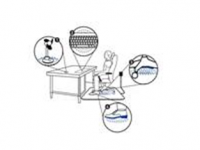Wirelessly Powered Heating and Cooling Devices

Technology Description:
The University of California, Berkeley (UC Berkeley) will team with WiTricity to develop and integrate highly resonant wireless power transfer technology to deliver efficient local thermal amenities to the feet, hands, face, and trunk of occupants in workstations. Until now, local comfort devices have had little market traction because they had to be tethered by a cord to a power source. The team will leverage on-going developments in wireless charging systems for consumer electronics to integrate high-efficiency power transmitting devices with local comfort devices such as heated shoe insoles and cooled and heated office chairs. The team will develop four types of local comfort devices to deliver heating and cooling most effectively. The devices will draw very little electrical power and enable potential HVAC energy savings of at least 30%.
Potential Impact:
If successful, DELTA technology could increase energy efficiency, reduce emissions produced by powering traditional HVAC systems, and enable more sustainable heating and cooling architectures for energy-efficient building design.
Security:
If successful, DELTA technology could increase energy efficiency, reduce emissions produced by powering traditional HVAC systems, and enable more sustainable heating and cooling architectures for energy-efficient building design.
Environment:
The heating and cooling of buildings generates about 16% of the U.S. domestic greenhouse gas emissions. Through improved utilization of energy produced by fossil fuels with full adoption DELTA can reduce these emission by 2%.
Economy:
DELTA program innovations can help U.S. businesses eventually reduce reliance on tightly controlled building environments, thus enabling radical and sustainable architecture in next-generation energy-efficient building designs.
Contact
ARPA-E Program Director:
Dr. Jennifer Gerbi
Project Contact:
Dr. Hui Zhang
Press and General Inquiries Email:
ARPA-E-Comms@hq.doe.gov
Project Contact Email:
zhanghui@berkeley.edu
Related Projects
Release Date:
04/29/2014
